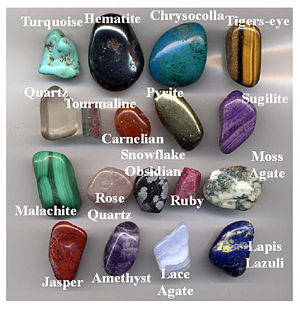Gemology

Gemology or gemmology is the science, art and profession of identifying and evaluating gemstones. It is considered a geoscience and a branch of mineralogy. Some jewelers are academically trained gemologists and are qualified to identify and evaluate gems.
With further post-graduate training and experience they can qualify as appraisers (valuers). There are numerous professional schools and associations of gemologists and certification programs all over the world.
Some gemologists specialize in various gemstones, such as diamonds or emeralds. The laboratory gemologists are expert in identification of origin.
Recently, the demand for gemological services has grown, as increasing quantities of synthetic gems such as cubic zirconia and synthetic moissanite are manufactured. Gemologists perform such work as the identification of synthetic and natural gemstones, fracture-filled gemstones, and color-enhanced or treated natural gemstones.
Gemstones are basically categorized based on of their crystal structure, specific gravity, refractive index, and other optical properties, such as pleochroism. The physical property of "hardness" is defined by the non-linear Mohs scale of mineral hardness.
Gemologists study these factors while valuing or appraising cut and polished gemstones. Gemological microscopic study of the internal structure is used to determine whether a gem is synthetic or natural by revealing natural fluid inclusions, and included partially melted exogenous crystals to demonstrate evidence of heat treatment to enhance colour.
The spectroscopic analysis of cut gemstones also allows a gemologist to understand the atomic structure and identify its origin as it is a major factor in valuing a gemstone.
For example, a ruby from Burma will have definite internal and optical activity variance as compared to a Thai ruby.
When the gemstones are in a rough state, the gemologist studies the external structure; the host rock and mineral association; and natural and polished colour. Initially, the stone is identified by its colour, refractive index, optical character, specific gravity, and examination of internal characteristics under magnification.
Contents |
General Identification of Gems
Gem identification is basically a process of elimination. Gemstones of similar color undergo non-destructive optical testing until there is only one possible identity. Any single test is indicative, only. For example, the specific gravity of ruby is 4.00, glass is 3.15-4.20, and cubic zirconia is 5.6-5.9. So, one can easily tell the difference between cubic zirconia and the other two; however, there is overlap between ruby and glass.
And, as with all naturally occurring material(s), no two gems are identical. The geological environment they are created in influences the overall process so that although the basics can be identified the presence of chemical "impurities" and substitutions along with structural imperfections vary thus creating "individuals".
Identification by Refractive Index
One test to determine the gem's identity is to measure the refraction of light in the gem. Every material has a critical angle, at which point light is reflected back internally. This can be measured and thus used to determine the gem's identity. Typically, this is measured using a refractometer although it is possible to measure it using a microscope.
Identification by Specific Gravity
Specific gravity, also known as relative density, is different depending upon the chemical composition and crystal structure type. Heavy liquids with a known specific gravity are used to test loose gemstones.
Specific Gravity is measured by comparing the weight of the gem in air with the weight of the gem suspended in water.
Identification by Spectroscopy
This method uses a similar principle to how a prism works to separate white light into its component colors. A gemological spectroscope is employed to analyze the selective absorption of light in the gem material. Essentially, when light passes from one medium to another, it bends. Blue light bends more than red light. Depending on the gem material, it will adjust how much this light bends. Coloring agents or chromophores show bands in the spectroscope and indicate which element is responsible for the gems color. The wavelengths displayed are measured in nanometers.
Identification by Magnification
External links
- The Gemmological Association and Gem Testing Laboratory of Great Britain
- The Gemological Institute of America
- The Gemological Institute of America - London
- The International Gemological Institute
- The Gemmological Association of Australia
- Far East Gemological Institute Singapore
- The Canadian Institute of Gemmology - Gemology World
- The Canadian Gemmological Association
- SSEF Swiss Gemmological Institute, Switzerland SSEF
- Gübelin Gem Lab, Switzerland